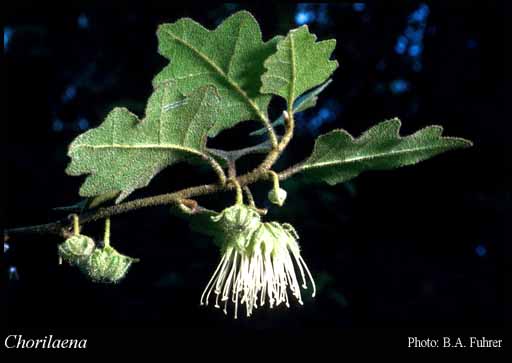- Reference
- Enum.Pl. p17 (1837)
- Name Status
- Current

Scientific Description
Family Rutaceae.
Habit and leaf form. Shrubs; evergreen, or deciduous; bearing essential oils. Mesophytic, or xerophytic. Leaves alternate; leathery, or ‘herbaceous’; petiolate; non-sheathing; gland-dotted; aromatic; simple. Leaf blades dissected, or entire; when simple/dissected pinnatifid, or much-divided; pinnately veined, or one-veined. Leaves without stipules, or with stipules. Stipules when present, intrapetiolar; represented by glands. Leaves without a persistent basal meristem. Leaf anatomy. Hairs present; complex hairs present. Complex hairs stellate. Stem anatomy. Nodes unilacunar, or tri-lacunar. Secondary thickening developing from a conventional cambial ring.
Reproductive type, pollination. Fertile flowers hermaphrodite. Unisexual flowers absent. Plants hermaphrodite. Entomophilous.
Inflorescence and flower features. Flowers aggregated in ‘inflorescences’; in umbels (umbels pedunculate, 6-flowered). The terminal inflorescence unit cymose, or racemose. Inflorescences axillary. Flowers bracteate; bi- bracteolate; small to medium-sized; fragrant; regular, or somewhat irregular. The floral asymmetry when noticeable, involving the perianth and involving the androecium (not K). Flowers 5 merous; cyclic. Floral receptacle developing a gynophore (associated with the disk), or with neither androphore nor gynophore. Free hypanthium absent. Hypogynous disk present (small, lobed); intrastaminal; annular (sometimes one-sided), or of separate members. Perianth with distinct calyx and corolla; 10; 2 -whorled; isomerous. Calyx present; 5; 1 -whorled; gamosepalous; deeply lobed; lobes valvate; hemispherical; regular; with the median member posterior. Corolla 5; 1 -whorled; polypetalous; valvate; regular, or unequal but not bilabiate. Androecium 10. Androecial members free of the perianth; all equal, or markedly unequal; free of one another; 1 -whorled, or 2 -whorled. Stamens 10; diplostemonous; alternisepalous. Filaments hairy (bearded near base, otherwise glabrous); slender, thickened near base. Anthers dorsifixed, or basifixed (? more or less); versatile; dehiscing via longitudinal slits; introrse, or latrorse; tetrasporangiate; appendaged; minutely apiculate (apiculum non-glandular). Gynoecium (1–)3 carpelled, or 4–5(–100) carpelled. The pistil when syncarpous, (1–)4–5(–100) celled. Gynoecium apocarpous, or syncarpous; eu-apocarpous, or semicarpous, or synstylous; superior. Carpel (when apo- or semicarpous) (1–)2–100 ovuled. Placentation of the free carpels marginal. Ovary plurilocular; when syncarpous, (1–)4–5(–100) locular. Styles 1, or 3–5; free, or partially joined; lateral to ‘gynobasic’ (ovary apex short and solid). Stigmas 5 - lobed; wet type, or dry type; papillate, or non-papillate; Group II type, or Group IV type. Placentation when syncarpous, axile. Ovules 1–5(–50) per locule; pendulous to ascending; epitropous; when two or more per cell, collateral, or superposed, or biseriate; arillate, or non-arillate; anatropous, or hemianatropous.
Fruit and seed features. Fruit fleshy, or non-fleshy; an aggregate, or not an aggregate. The fruiting carpels coalescing into a secondary syncarp, or not coalescing. The fruiting carpel dehiscent, or indehiscent; (when apocarpous) a follicle, or drupaceous, or baccate. Fruit (when syncarpous) dehiscent, or indehiscent, or a schizocarp. Mericarps when schizocarpic, comprising berrylets, or comprising follicles, or comprising nutlets, or comprising drupelets. Fruit when syncarpous and non-schizocarpic, a berry, or a drupe. Seeds reniform; endospermic, or non-endospermic. Embryo well differentiated. Cotyledons 2. Embryo chlorophyllous, or achlorophyllous; straight, or curved, or bent. Seedling. Germination phanerocotylar, or cryptocotylar.
Physiology, biochemistry. Aluminium accumulation not found. Photosynthetic pathway: C3.
Geography, cytology, number of species. A genus of 1 species.
Additional characters Petals multinerved.